
Interior Alaska is the central region of Alaska's territory, roughly bounded by the Alaska Range to the south and the Brooks Range to the north. It is largely wilderness. Mountains include Denali in the Alaska Range, the Wrangell Mountains, and the Ray Mountains. The native people of the interior are Alaskan Athabaskans. The largest city in the interior is Fairbanks, Alaska's second-largest city, in the Tanana Valley. Other towns include North Pole, just southeast of Fairbanks, Eagle, Tok, Glennallen, Delta Junction, Nenana, Anderson, Healy, and Cantwell. The interior region has an estimated population of 113,154.

The Yukon River is a major watercourse of northwestern North America. From its source in British Columbia, it flows through Canada's territory of Yukon. The lower half of the river continues westward through the U.S. state of Alaska. The river is 3,190 kilometres (1,980 mi) long and empties into the Bering Sea at the Yukon–Kuskokwim Delta. The average flow is 6,400–7,000 m3/s (230,000–250,000 cu ft/s). The total drainage area is 854,700 km2 (330,000 sq mi), of which 323,800 km2 (125,000 sq mi) lies in Canada. The total area is more than 25% larger than Texas or Alberta.
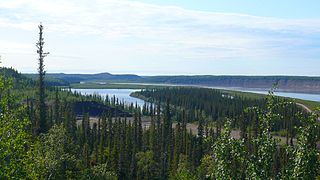
The Mackenzie River is a river in the Canadian boreal forest. It forms, along with the Slave, Peace, and Finlay, the longest river system in Canada, and includes the second largest drainage basin of any North American river after the Mississippi.
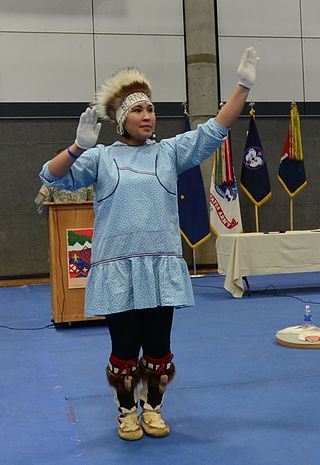
Alaska Natives are the Indigenous peoples of Alaska and include Russian Creoles, Iñupiat, Yupik, Aleut, Eyak, Tlingit, Haida, Tsimshian, and a number of Northern Athabaskan cultures. They are often defined by their language groups. Many Alaska Natives are enrolled in federally recognized Alaska Native tribal entities, who in turn belong to 13 Alaska Native Regional Corporations, who administer land and financial claims.

The Kobuk River, also known by the names Kooak, Kowak, Kubuk, Kuvuk, and Putnam, is a river located in the Arctic region of northwestern Alaska in the United States. It is approximately 280 miles (451 km) long. Draining a basin with an area of 12,300 square miles (32,000 km2), the Kobuk River is among the largest rivers in northwest Alaska, with widths of up to 1,500 feet and flows reaching speeds of 3–5 miles per hour in its lower and middle reaches. The average elevation for the Kobuk River Basin is 1,300 feet (400 m) above sea level, ranging from sea level at its mouth on the Bering Sea to 11,400 feet near its headwaters in the Brooks Range.
The Green Belt Movement (GBM) is an indigenous grassroots organization in Kenya that empowers women through the planting of trees. It is one of the most effective and well-known grassroots organisations addressing the problem of global deforestation. Professor Wangari Maathai established the organization in 1977 under the auspices of the National Council of Women of Kenya (NCWK). GBM's successes in forest conservation, education, and women's economic empowerment have gained the organisation worldwide acclaim. It is also noted for its advocacy of human rights, democratisation of access to public lands, and environmental justice issues such as the role of women's traditional ecological knowledge in addressing environmental degradation and desertification.
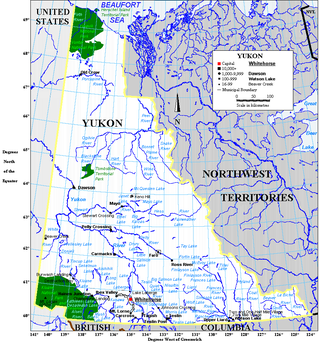
Yukon is in the northwestern corner of Canada and is bordered by Alaska, British Columbia and the Northwest Territories. The sparsely populated territory abounds with natural scenery, snowmelt lakes and perennial white-capped mountains, including many of Canada's highest mountains. The territory's climate is Arctic in territory north of Old Crow, subarctic in the region, between Whitehorse and Old Crow, and humid continental climate south of Whitehorse and in areas close to the British Columbia border. Most of the territory is boreal forest with tundra being the main vegetation zone only in the extreme north and at high elevations.
Environmental issues in Pakistan include air pollution, water pollution, noise pollution, climate change, pesticide misuse, soil erosion, natural disasters, desertification and flooding. According to the 2020 edition of the environmental performance index (EPI) ranking released by Yale Center for Environmental Law & Policy, Pakistan ranks 142 with an EPI score of 33.1, an increase of 6.1 over a 10-year period. It ranked 180 in terms of air quality. The climatic changes and global warming are the most alarming issues risking millions of lives across the country. The major reasons of these environmental issues are carbon emissions, population explosion, and deforestation.
Chattahoochee Riverkeeper (CRK) -- formerly known as Upper Chattahoochee Riverkeeper (UCR) -- is an environmental advocacy organization with 10,000 members dedicated solely to protecting and restoring the Chattahoochee River Basin. CRK was modeled after New York’s Hudson Riverkeeper and was the 11th licensed program in the international Waterkeeper Alliance. In 2012, the organization officially changed its name to simply Chattahoochee Riverkeeper (CRK), dropping the "Upper" to better reflect its stewardship over the entire river basin.

A fish wheel, also known as a salmon wheel, is a device situated in rivers to catch fish which looks and operates like a watermill. However, in addition to paddles, a fish wheel is outfitted with wire baskets designed to catch and carry fish from the water and into a nearby holding tank. The current of the river presses against the submerged paddles and rotates the wheel, passing the baskets through the water where they intercept fish that are swimming or drifting. Naturally, a strong current is most effective in spinning the wheel, so fish wheels are typically situated in shallow rivers with brisk currents, close to rapids, or waterfalls. The baskets are built at an outward-facing slant with an open end so the fish slide out of the opening and into the holding tank where they await collection. Yield is increased if fish swimming upstream are channeled toward the wheel by weirs.

Arctic ecology is the scientific study of the relationships between biotic and abiotic factors in the arctic, the region north of the Arctic Circle. This region is characterized by two biomes: taiga and tundra. While the taiga has a more moderate climate and permits a diversity of both non-vascular and vascular plants, the tundra has a limited growing season and stressful growing conditions due to intense cold, low precipitation, and a lack of sunlight throughout the winter. Sensitive ecosystems exist throughout the Arctic region, which are being impacted dramatically by global warming.

The Nile Basin Initiative (NBI) is a partnership among the Nile riparian states that “seeks to develop the river in a cooperative manner, share substantial socioeconomic benefits, and promote regional peace and security”. The NBI began with a dialogue among the riparian states that resulted in a shared vision objective “to achieve sustainable socioeconomic development through the equitable utilization of, and benefit from, the common Nile Basin water resources." It was formally launched in February 1999 by the water ministers of nine countries that share the river: Egypt, Sudan, Ethiopia, Uganda, Kenya, Tanzania, Burundi, Rwanda, the Democratic Republic of Congo (DRC), as well as Eritrea as an observer. From its beginning the Nile Basin Initiative has been supported by the World Bank and by other external partners. The World Bank has a mandate to support the work of the NBI, as lead development partner and as administrator of the multi-donor Nile Basin Trust Fund. One of the partners is the "Nile Basin Discourse", which describes itself as "a civil society network of organisations seeking to achieve positive influence over the development of projects and programmes under the Nile Basin Initiative".
The Project on Indigenous Governance and Development, previously named the Harvard Project on American Indian Economic Development, also known as the Harvard Project, was founded in 1987 at Harvard Kennedy School at Harvard University. It administers tribal awards programs as well as provides support for students and conducting research. The Harvard Project aims to understand and foster the conditions under which sustained, self-determined social and economic development is achieved among American Indian nations through applied research and service.
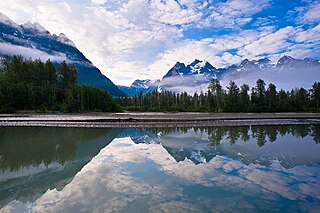
Rivers Without Borders is a nonprofit organization fiscally sponsored by the Tides Center in the United States. Rivers Without Borders works as a project of Tides Canada Initiatives in Canada. Tides Canada's mission is to provide uncommon solutions for the common good by leading and supporting actions that foster a healthy environment and just Canadian society.

The Arctic policy of the United States is the foreign policy of the United States in regard to the Arctic region. In addition, the United States' domestic policy toward Alaska is part of its Arctic policy.

Clarence Lee Alexander is a former Grand Chief of the Gwich'in of Alaska. He was 1st Chief of Fort Yukon from 1980 to 1994. He was raised at "Shoo Taii," the "Happy Hill," which is also known by the name "Alexander Village". Alexander Village is approximately 20 miles north of Fort Yukon. He co-authored the Gwich'in Dictionary with his wife, Virginia E. Alexander.

The Yukon River Basin is located between the Yukon Territory in Canada and Alaska in the United States, with a small portion in British Columbia, Canada. This basin is made up of 13 other individual basins that drain into the Yukon River and other adjoining rivers and tributaries. The Yukon River Basin is 330,000 square miles (850,000 km2) in area and 1,980 miles (3,190 km) in length. Many different geological features make up the basin, including several types of terrain, shrubland, and rivers.
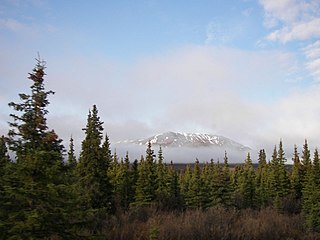
The Taiga of North America is a Level I ecoregion of North America designated by the Commission for Environmental Cooperation (CEC) in its North American Environmental Atlas.













